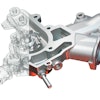There are many ways to categorize today’s consumer behavior, but one of the most recognizable and impactful characteristics (especially of our tech-savvy youth) is impatience. With our necks craned over glowing screens — either at desks, on the couch, or on the bus — we can fulfill most of our consumer desires with just a tap of the glass.
While we tend to think of the B2C online and brick-and-mortar retailers as the only ones who have to accommodate the rapidly changing needs of today’s shopper, all industries are affected by this trend. It’s important to remember that because product demand affects all levels of a supply chain, manufacturers are also exposed to and impacted by the increasing need for immediacy of American consumers.
At my company, we keep an open line of communication with manufacturing clients to understand what’s critical for them on any given day. There are three trends we’ve been hearing lately that are impacting our manufacturing partners: the ability to accurately forecast demand (and being flexible in order to include new variables), material planning (including just-in-time delivery and supplier variety), and the ability to manage offshore and local production.
Forecasting
Forecasting is one of the keys to any successful business, it’s particularly important for manufacturers. They have an overwhelming number of variables to juggle, from raw material procurement to supplier and customer constraints, in addition to managing money and hard goods. There are plenty of point solutions for demand forecasting, but there’s a severe disconnect between these analysis platforms and traditional ERP. Point solutions can be difficult to integrate, and create departmental gaps among procurement, sales and the supply chain management teams. If these groups are working in separate systems, supply chain management teams are rarely viewing the same reports or being exposed to the external and internal variables (or constraints) on revenue and procurement that would have a measureable impact on output recommendations. Using the latest ERP software that has a native and flexible demand forecasting tool will break down departmental silos and increase access to data so that all teams can work on strategies to meet the demand being driven by consumers.
Materials Planning
Today’s interconnected world gives manufacturers access to materials from an endless stream of sources. While this has been a boon to both early-stage manufacturers who need access to affordable and reliable resources and legacy production houses, the complexity of global supply chain management forces companies to keep a keen eye on the variables that will affect their production capacity. Materials resource planning (MRP) is a familiar term to manufacturers who have been around a long time. Industry veterans may remember that MRP was once only accessible to enterprises that could afford expensive hardware and engineers required to maintain the software that accurately planned components. The rise of multi-tenant cloud and ERP has broken down the barriers that prevented small and midsized manufacturers from using this software. Today, MRP has gone from being a luxury to being a requirement in order to manage the many factors influencing both demand on the customer side and constraints on the supplier side. As such, a fully integrated MRP solution connects and streamlines all the components of just-in-time manufacturing, including accurate analysis of supplier lead time, production capacity and scheduling.
Offshore + Onshore Production Management
Through the late sixties and early seventies, there was a dramatic shift from local production to offshore manufacturing. Technology advancements and the discovery of large natural resources abroad made it possible for national manufacturers to export high-volume and repetitive production overseas, reducing variable and fixed costs and bringing them closer to end consumers — which were spread across the globe. Now, we’re seeing a stark pivot with U.S. companies looking to bring some of those manufacturing process back stateside. Many former contract manufacturers are now responsible for up to 100 percent of the production of their goods. But most still retain a large dependence on foreign suppliers that have significantly greater manufacturing capacity. In the near-term, we’re working with manufacturers who are heavily reliant on a hybrid offshore & local production model — where they’re responsible for accurately predicting constraints defined by overseas variables (quality, lead time, etc.) and coordinating those with manufacturing capabilities in the U.S. A robust end-to-end ERP platform is a critical part of this equation in order to balance currency fluctuations, track landed costs and manage multiple cost centers. All these factors play into the bottom line - work order profitability.
Cameron Ackbury is the U.S. president of Deskera.





















